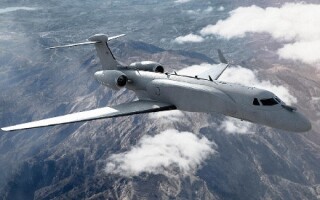Navy officials take over full operation control of fifth MUOS satellite
NewsNovember 16, 2017

NAVAL BASE VENTURA COUNTY, POINT MUGU, Calif. Naval Satellite Operations Center (NAVSOC) officials accepted full operation control of the fifth Mobile User Objective System (MUOS) satellite from Lockheed Martin and the Navy?s Communications Satellite Program Office (PMW 146).
The handover of this satellite to NAVSOC clears the final hurdle allowing Army Forces Strategic Command (ARSTRAT) officials to provide the payload’s final configurations to support the Navy's legacy UHF satellite communications mission.
This milestone was followed by the completion of the MUOS-5 satellite’s on-orbit testing and delivery of all operational products needed to “fly” the satellite. In April, the Navy, working with ARSTRAT, configured one of MUOS-5's two communications payloads – its legacy Ultra High Frequency (UHF) payload – for testing.
“Today, every Combatant Command in aircraft, ships, submarines, ground vehicles, as well as by troops in the field and special operations, rely upon secure, beyond-line-of-sight UHF satellite communications provided by the Navy,” says Mark Woempner, Lockheed Martin’s director for Narrowband Communications. “ARSTRAT’s final configuration of MUOS-5’s UHF legacy payload allows the satellite to fully support our military forces in these Combatant Commands.”
Eventually, legacy narrowband UHF communications will transition to next generation Wideband Code Division Multiple Access (WCDMA) capabilities. To facilitate that transition, all five on-orbit MUOS satellites were intentionally designed with two communications payloads to support both Legacy UHF and WCDMA.
Once fully operational, the MUOS network of five on-orbit satellites and four relay ground stations will provide more than 10 times the communications capacity of the legacy UHF satellite system. MUOS’ network already provides near-global coverage, including communications into polar regions. MUOS also has demonstrated successful communication of Integrated Broadcast Service (IBS) messages.
“We continue to receive great and constructive feedback on MUOS’ capabilities as more users try it out. Similar to a civilian cellular phone service, upgrades to this new secure global military cellular network are ground-based and designed in an AGILE software development environment. We continue to make upgrades to the system based on user needs and look forward to bringing its full capabilities to our warfighters,” Woempner adds.
Today there are more than 55,000 radio terminals currently fielded that can be upgraded to be MUOS-compatible, with many of them requiring just a software upgrade.
The Navy's Program Executive Office for Space Systems and its Communications Satellite Program Office responsible for the MUOS program are based in San Diego, California. Lockheed Martin assembled and tested all five now-on-orbit MUOS satellites at its Sunnyvale, California, facility.
Read more on satellite communications:
The power of light: A shortcut to satellite-based quantum encryption
Secure satellite communications for warfighters on the move
Military secure satellite communications capacity is evolving rapidly








